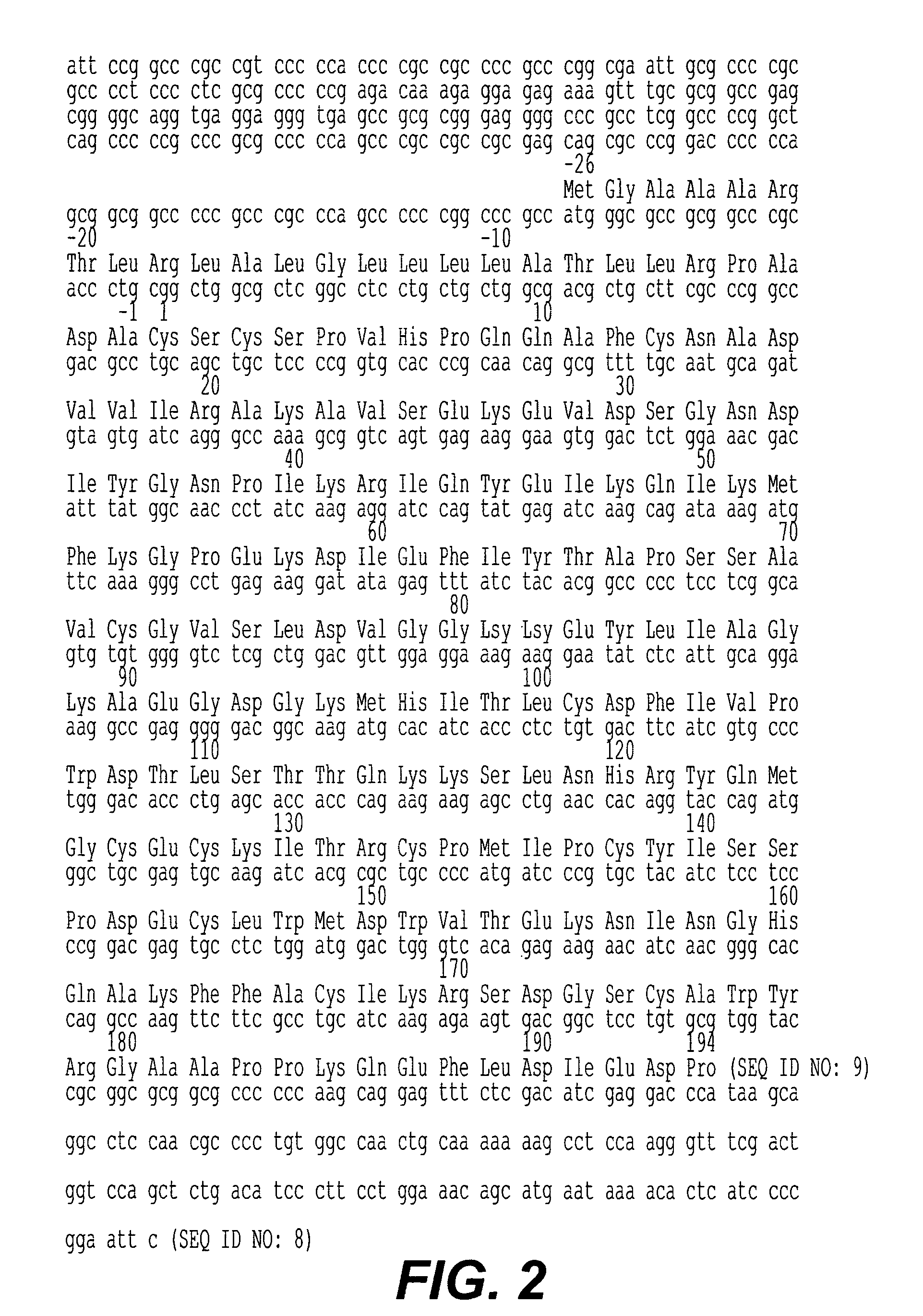Methods for detecting metalloproteinase inhibitors
a technology of metalloproteinase inhibitor and detection method, which is applied in the direction of peptides, chemical treatment enzyme inactivation, enzymology, etc., can solve the problems of limited measurement of metalloproteinases to collagenase, and the inability to provide an adequate source of materials from culture of naturally occurring cells
- Summary
- Abstract
- Description
- Claims
- Application Information
AI Technical Summary
Benefits of technology
Problems solved by technology
Method used
Image
Examples
example 1
Purification / Characterization of Metalloproteinase Inhibitors from Bovine Aortic Endothelial Cell Conditioned Medium.
[0075]Bovine aortic endothelial cells (cell line NCACl2; De Clerck et al., Cancer Research, supra) were cultured in Eagle's Minimum Essential Medium (MEM) containing fetal bovine serum (2%, v / v) supplemented with MITO+ serum extender (2%, v / v; Collaborative Research, Inc., Bedford, Mass.), penicillin (100 U / ml) and streptomycin (100 μg / ml). Cells between passage 10 and 20 were grown in 800 cm2 roller bottles (Costar). For conditioning, cultures at 80-90% confluence were washed 3 times with serum-free medium over 4 to 5 h and then incubated in the presence of fresh serum-free medium for 48 h. The medium was collected, centrifuged at 5,000×9 for 10 min at 4° C. and kept at 4° C. after addition of sodium azide (0.02%, w / v). After the conditioning, cells were trypsinized, diluted 1:4 with medium, and grown to 80% confluence for reconditioning.
2. Inhi...
example 2
Amino-Terminal Amino Acid Sequence Analysis of Peak I-Derived Inhibitor and Peak II-Derived Inhibitor; Amino Acid Composition Analysis of Peak I-Derived Inhibitor
[0113]Peak I-derived inhibitor (4.8 ml; Table 1, step 2.1.3) was concentrated and introduced into 50 mM ammonium bicarbonate, pH 7.8 using an Amicon Centricon 10 ultrafiltration unit. The sample was spotted onto a glass fiber disc on a sequencer cartridge, which had been pre-cycled with polybrene. The glass fiber disc containing sample was dried under a stream of N2. Amino-terminal amino acid sequence analysis was performed according to published methods [Hewick et al., J. Biol. Chem. 256, 7990-7997 (1981)] with Applied Biosystems Model 477 protein sequencer using a standard program provided by Applied Biosystems (Foster City, Calif.). The released phenylthiohydantoin (PTH)-amino acids were analyzed by a Model 120 on-line PTH-amino acid analyzer using a Brownlee reverse phase C-18 column. The chromatograms obtained were an...
example 3
Cloning of the Bovine and Human Metalloproteinase Inhibitor Genes.
[0125]The amino-terminal amino acid sequence for the bovine metalloproteinase inhibitor was determined as described above and 3 probes were designed and manufactured on DNA synthesizers (Applied Biosystems models 380A and 380B) for hybridization to the sense strand of DNA (or to the mRNA). The first probe was designed as a long nondegenerate probe by the method of Lathe [J. Mol. Biol. 183, 1-12 (1985)] to recognize the region corresponding to amino acids 4 to 19 and is as follows:
[0126]
(SEQ ID NO: 15)5′ GAT CAC AAT GTC AGC ATT GCA GAA GGC CTG CTG GGGATG CAC AGG 3′
The second and third probes were designed as degenerate probes incorporating inosine bases at positions of 4-fold degeneracy. The second probe recognizes the region corresponding to amino acids 21 to 30 and is as follows:
[0127]
(SEQ ID NO: 16) (T) (T) (T) (T)5′ GTC IAC (C)TC (C)TT (C)TT GTT IAC IGC (C)TTIGC 3′
The parentheses indicat...
PUM
| Property | Measurement | Unit |
|---|---|---|
| v/v | aaaaa | aaaaa |
| volume | aaaaa | aaaaa |
| Flow rate | aaaaa | aaaaa |
Abstract
Description
Claims
Application Information
 Login to View More
Login to View More - Generate Ideas
- Intellectual Property
- Life Sciences
- Materials
- Tech Scout
- Unparalleled Data Quality
- Higher Quality Content
- 60% Fewer Hallucinations
Browse by: Latest US Patents, China's latest patents, Technical Efficacy Thesaurus, Application Domain, Technology Topic, Popular Technical Reports.
© 2025 PatSnap. All rights reserved.Legal|Privacy policy|Modern Slavery Act Transparency Statement|Sitemap|About US| Contact US: help@patsnap.com



